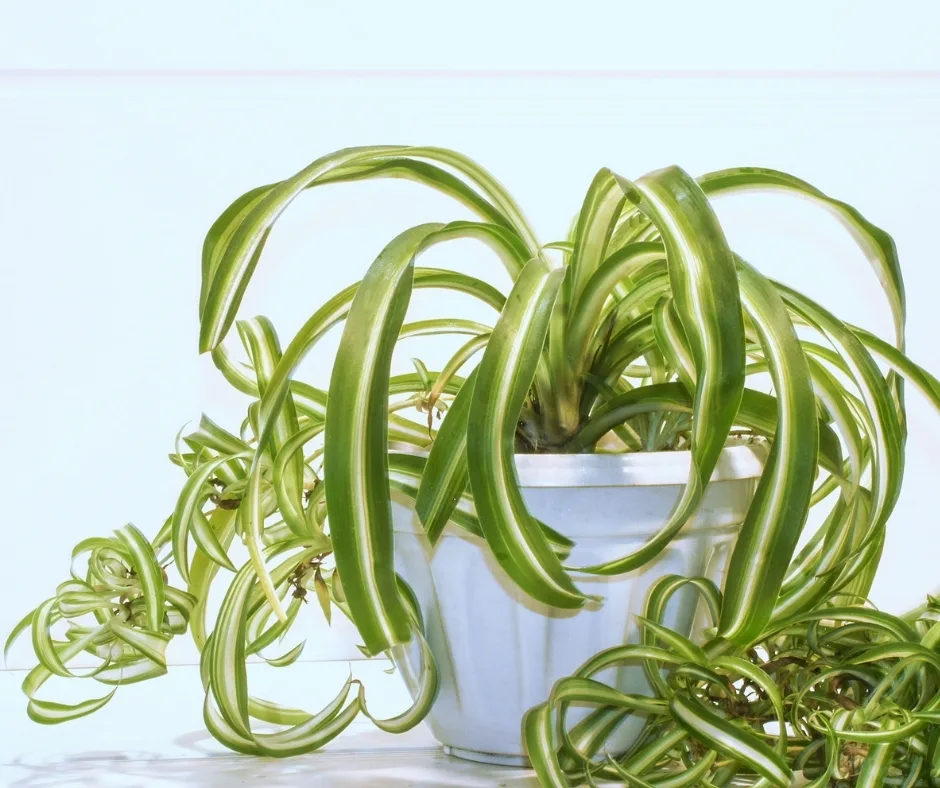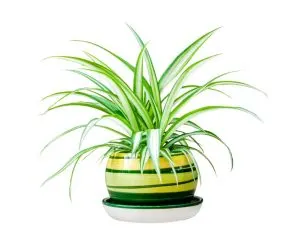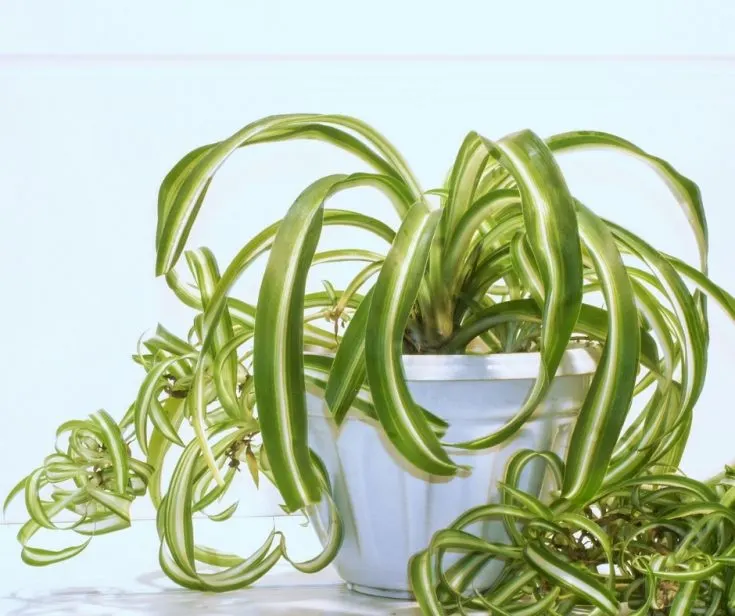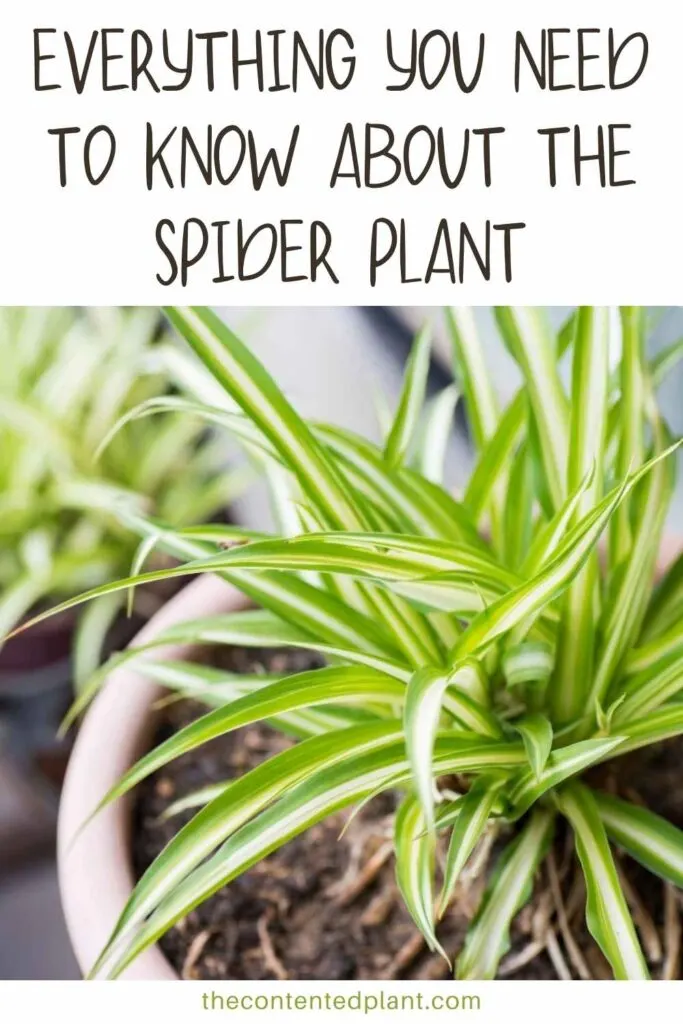The Spider Plant is an extremely popular houseplant that has grass like leaves with beautiful striping down the center.
This plant gets its name from the little spiderettes it produces from the Mother plant. Overall this is an easy houseplant to care for and makes a great gift for beginner plant parents.
The spider plant can survive in lower lighting conditions and can go longer in between waterings than most plants. This plant can be grown as a tabletop plant or in a hanging basket.

According to various studies this plant is an excellent air cleaning plant. It has even absorbs Formaldehyde, Benzene, Carbon Monoxide, and Xylene from the air.
Leaf tips browning
One of the top concerns with the spider plants is the tips of the leaves turning brown. There are a few different reasons this could be happening to your plant.
- An uneven watering schedule (watering sporadically) try to water once every 2 weeks or when soil is dry 50% down.
- Lack of humidity. Most houseplants benefit from a humid environment. If your house is extremely dry you can try adding a pebble tray or a small humidifier next to your plant.
- Fluoride filled water can burn houseplants. You can try using distilled water if your tap water has a high fluoride content.
- A buildup of fertilizer can also cause browning tips on the spider plant. Use a lower concentration fertilizer, if you suspect that this is the issue, you can flush the roots with water and repot into new soil.
You can cut the tips of browning leaves off of the plant with sharp sterile scissors.

Finding a spider plant to purchase is fairly simple. They are readily available in most nurseries or greenhouses. However, if you can’t locate one or you would like to find a rarer variety you can try Etsy.
Shop Spider Plants on Etsy

Spider Plant Care Guide

The Spider Plant grows upright with trailing runner vines. These vines produce baby offshoots or "spiderettes" off of the mother plant.
This plant has been popular for decades and is an easy plant to care for.
This Care Guide will teach you how to keep this plant happy all through the year.
Materials
Tools
Instructions
Soil Preference:
- This plant requires a quick draining soil.
- A mix of potting soil and perlite will keep the roots happiest.
- Two parts potting soil to one part perlite.
- A heavy soil potting mix is not recommended for these plants.
Pot Size and Type:
- The Spider plant can grow in a regular pot.
- This plant grows quite quickly and may need to be repotted once a year
- If you want to encourage faster growth choose a pot about 2 inches wider in diameter than the current pot.
- Any well drained pot can be used. It MUST have drainage.
- Repot every year or when roots come out the drainage holes on the pot bottom To the next pot size up.
- Don't jump to a huge pot from a small one unless you wish to encourage faster growth. Just go to the next size up pot.
Lighting:
- The spider plant enjoys bright indirect or dappled light.
It will tolerate lower indirect light if it has some brighter moments in the day. - Some filtered sunlight from a window will be appreciated.
- Shield this plant from strong direct light in summer south and west sunny windows. The leaves will get scorched.
- This plant can grow slowly if kept in low light
- Tip: Window sheers or blinds can offset some brief periods of high direct light.
Watering:
- Water your plant when the soil is dry. Try a watering schedule of every other week.
- Watering is best done on a regular schedule so the plant is not over or under watered. Both can cause stress on the plant.
- In dry climates this plant will thrive with a humidifier nearby. OR use a pebble tray under the pot filled half way with water.
- In dormant winter months reduce watering to when the soil is dry.
- Never let this plant get wet feet. Water when the top 2 inches of soil are dry. If the soil is compacted the bottom of the soil can remain wet which encourages root rot and fungus gnats.
How to Fertilize:
- Apply a good quality fertilizer (linked in materials) monthly through Spring and summer.
- Use a low concentration fertilizer and make sure the leaves are not browning.
- Decrease feedings by late Fall and allow the plant to rest through the winter months.
Temperature:
- Keep the plant at a low of 65 Degrees F. to upward of 85 Degrees F. It enjoys warmth and humidity.
Pests:
- This plant is not fussy and resists pests. However all plants can get attacked by pests.
- Stress by longterm overwatering, poor light, extreme temperatures and soil conditions are contributors to plant stress..
- Spider mites, mealy bugs, scale, thrips and whitefly are the most common houseplant pests you will see.
- Read our post on How to get rid of aphids and other pests with our homemade pesticide soap recipe or neems oil.
- To minimize the possibility of pests be sure to check all nursery plants before bringing them home.
- Quarantine all new plants until you are sure no pests live in them.
How to Propagate:
- The Spider plant grows long running vines with baby plant offshoots
- These offshoots often called "spiderettes" can be snipped off to create a new plant
- Use sharp sterile scissors to cut the baby plant from the mother plant
- You can pot the baby plant directly into moist soil
- The baby plant can also be propagated in water if you prefer.
Notes
This plant is non toxic to both pets and children
You can read more about the Spider Plant
Follow Us:
Find us on YouTube, Instagram , Pinterest and TikTok! We love to Plant chat. We also comment, like and occasionally share your content to our daily stories. We’d love to see your plants. Share your joy in your houseplants. Happy Planting!


Snake Plant Watering Guide - The Contented Plant
Wednesday 19th of January 2022
[…] Spider Plant Care Guide and Profile […]